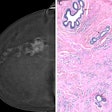A new study published online February 9 in the Journal of Clinical Oncology found that mammography screening rates declined after the 2009 publication of controversial screening guidelines by the U.S. Preventive Services Task Force (USPSTF).
A Harvard Medical School research team led by Frank Wharam analyzed breast screening rates three years after the publication of the USPSTF guidelines. Rates declined not only for younger women who were the main target of the guideline change, but also for women ages 50 to 64, considered the "sweet spot" in terms of mammography's effectiveness. The authors believe that the reduction in screening rates in these older women might be an "unintended consequence" of the guideline change (JCO, February 9, 2015).
In 2009, USPSTF rescinded its previous recommendation that women ages 40 and older receive screening every one to two years, instead advising women in their 40s to consult with their physicians about whether to undergo screening. The group also changed its recommendation for women 50 to 74, advising that screening take place every two years.
The researchers from Harvard wanted to examine the effect of the policy change on mammography screening rates, reviewing data both by age and by women's ethnic background. They reviewed enrollment information and administrative claims data for 2005 to 2012 from the Optum Clinformatics Data Mart dataset from a large national health plan with members in all 50 states. The study cohort included more than 2 million women per year during the study period.
Wharam and colleagues first calculated actual screening rates for different years; then they predicted what rates would have been if trends had continued in the absence of the USPSTF change.
They found that the annual screening rate among women ages 40 to 49 of all ethnic types was 38.8% in 2012, but it would have been 43.1% without the guideline change. That represented a decline of 4.3 percentage points, or 9.9%.
The annual screening rate for women ages 50 to 64 years of all ethnic types was 47.5%, but it would have been 50.7% without the guideline change, representing a difference of 3.3 percentage points, or 6.1%
For biennial screening, women of all ethnic groups ages 40 to 49 saw their rate drop to 65.8%, compared with a predicted rate of 71.9%. This represents a drop of 6.2 percentage points, or 9.0%.
Finally, biennial screening of women ages 50 to 64 was 76.5%, but it was predicted to be 81.2%, representing a drop of 4.7 percentage points, or 6.2%.
The researchers also found that all ethnic groups saw screening rates fall except for African-American women, who did not experience a statistically significant change.
In analyzing the results, the authors noted that supporters of the USPSTF policy change would probably be heartened by the decline in screening rates among younger women. But the decline in older women might be a cause for concern, especially among those who disagree with the 2009 guidelines.
"Advocates of a more intense breast cancer screening approach, as reflected in other consensus guidelines, are likely to consider all screening reductions concerning," the authors wrote. "These advocates might consider that decades of progress in increasing screening may have been reversed."



















